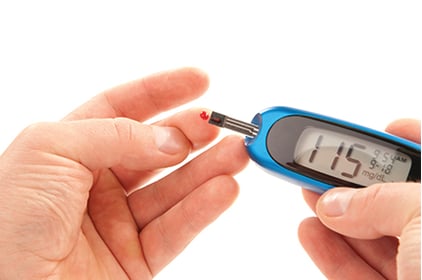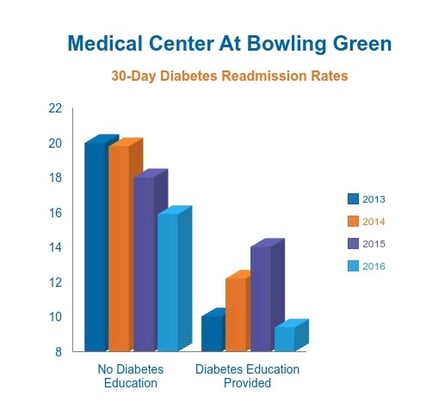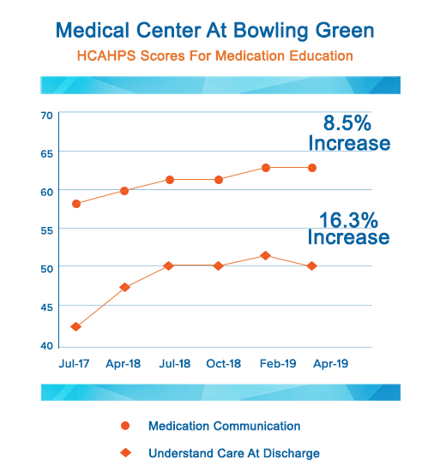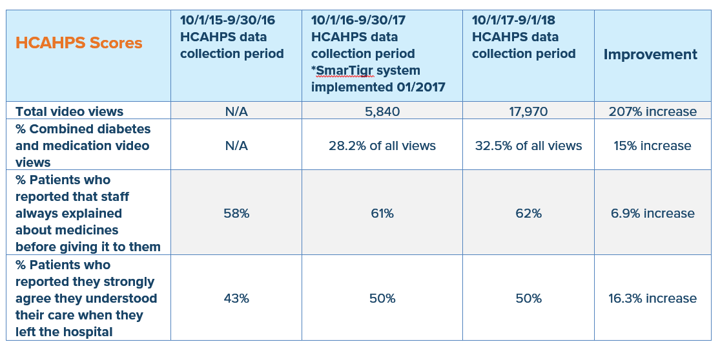Licensed Beds
337
Get in Touch!Call us at 800.999.8590 or Mon - Fri : 9 A.M. - 5 P.M. |
Already a Client?Need Support? |
NOTE: In April 2022 TeleHealth Services was rebranded under the name of our sister company, Avidex. The consolidation of our brands significantly enhances our capabilities to create better experiences for patients, visitors, and staff. Case studies may have been written under our former name, but now reflect the Avidex brand.
337
2009
Bowling Green, KY
2,000

Diabetes is a serious public health epidemic in the state of Kentucky, which has the 7th highest rate of the disease in the nation.¹ An estimated 50.8% of adults are touched by this disease, as 15.3% of the population has diabetes and an additional 35.5% has prediabetes.² The rate of diabetes in Kentucky has sharply increased over the past few decades, more than doubling from 6.4% in 2000 and sharply exceeding the nationwide rate of 10.5% today.³ Diabetes is one of the most costly chronic conditions, with an estimated annual expense of $5.2 billion to the state of Kentucky.⁴ The cost to health is felt by Kentuckians as well, as associated complications that threaten both length and quality of life include heart disease, stroke, blindness, nerve and blood vessel damage, kidney failure, lower-limb amputation, ketoacidosis, and death.⁵
Strengthening efforts to prevent new cases and improving self-management in those who have been diagnosed are recommended as part of a statewide approach to addressing diabetes in the 2017 Kentucky Diabetes Report.⁶ Under evidence-based guidelines for treatment and lifestyle management, diabetes can be controlled and sometimes avoided altogether. Communication of those guidelines to those living with diabetes or prediabetes is critical to changing the course of this dangerous and costly epidemic.
At The Medical Center at Bowling Green, Kentucky, diabetes education is a major focus of the hospital’s patient education program.
“One out of every four patients admitted to our hospital has diabetes,” states patient educator Andrea Sturm, BSN, RN, CDE, MLDE. “Education for these patients is essential to improving outcomes.”
 As the certified diabetes educator for the hospital, Ms. Sturm sees up to 12 patients daily for bedside teaching. Her visits, which are ordered by physicians, are prioritized to newly diagnosed diabetics and patients with the most critical needs. “On any given day, there can be up to 200 patients in our hospital with diabetes, so patient education is a shared responsibility. Dietitians, pharmacists, and especially staff nurses are charged with teaching patients about this disease and how to self-manage after leaving the hospital.”
As the certified diabetes educator for the hospital, Ms. Sturm sees up to 12 patients daily for bedside teaching. Her visits, which are ordered by physicians, are prioritized to newly diagnosed diabetics and patients with the most critical needs. “On any given day, there can be up to 200 patients in our hospital with diabetes, so patient education is a shared responsibility. Dietitians, pharmacists, and especially staff nurses are charged with teaching patients about this disease and how to self-manage after leaving the hospital.”
Without question, inpatient diabetes education is impactful and necessary. Since 2013, Ms. Sturm has been tracking 30-day diabetes readmissions.⁷ “Every year, we see lower readmissions among patients who receive diabetes education than among patients who do not.”
Consistent delivery of education, while recognized as essential, is riddled with challenges. The demands on the bedside
nursing role for direct care, coordination, documentation, and other essential functions limit time spent on teaching and psychosocial support (approximately 7% of nursing time).⁸ Other barriers exist around clinician competence and confidence with teaching disease-specific material to patients; novice and experienced nurses alike are hesitant to engage patients in education if they feel unqualified.⁹ Cultural diversity, language barriers, low literacy, acuity of patient
conditions, patient readiness to learn, and shorter length of stay all impact the ability of clinicians to provide meaningful education.
The Medical Center at Bowling Green identified video education as a means for establishing a standardized approach. Helpful for hospitalized adults, videos primarily serve to supplement clinician-led teaching and can enhance the retention of information over verbal instruction or print media alone.10 To facilitate delivery of video education, the Medical Center of Bowling Green
implemented the SmarTigr interactive patient engagement TV system in January 2017. The hospital added a robust library of videos to the system, including content from Staywell-Krames, Milner-Fenwick, X-Plain, and Healthy Roads Media.
Clinicians participated in go-live training to learn how to assign patient-specific education and launch videos on-demand through the computer-based StaffConnect application. Staff immediately appreciated the ease of managing the system from their workstations, as well as the benefit of automatic charting of patients’ video views to the EMR through an added interface. To further increase staff efficiency, condition-specific curricula were created to allow clinicians to easily prescribe videos in bundles, with 5 curricula focused specifically on diabetes. To facilitate patient access to the system, a ‘video prescription’ card was implemented with simple instructions for locating their assigned videos and launching them on their in-room televisions. Within a short time, utilization reports showed a steady increase in activity from month to month, with diabetes topics approximating one-fourth of the hospital’s total viewing activity.11 Since improving medication communication was another focus for The Medical Center, clinicians soon recognized the potential to use the system for educating patients on
Since improving medication communication was another focus for The Medical Center, clinicians soon recognized the potential to use the system for educating patients on
their prescribed medicines. “Medication adherence is one of the strongest predictors of improvement in outcomes, not only for patients with diabetes, but for persons with
any serious or chronic condition,” states Ms. Sturm.

In addition to using SmarTigr for video-on-demand, Ms. Sturm took advantage of opportunities to reach patients through the system’s passive education and messaging
features. A creative series of disease-specific education campaigns with call-to-action messages were developed for broadcast over the SmarTigr system. “As an example, we regularly see patients who have never had a glucose monitor, but they don’t always tell their doctors and nurses,” explains Ms. Sturm. On TV, a presentation featuring a series of short videos about diabetes plays in a loop above a text message which reads ‘If you don’t have a glucose monitor, we can help.’ An extension is listed for patients to call. “Patients are exposed to that message several times a day while they’re channel surfing,” states Ms. Sturm. “When I get a call from someone who has seen it and who needs a monitor, I bring one to the bedside, teach the patient how to use it, and explain how to get test strips through their insurer.”
"A medical crisis can be a powerful motivator." - Andrea Sturm, BSN, RN, CDE, MLDE Patient Educator, Medical Center at Bowling Green
Since the implementation of the SmarTigr system in January of 2017, video-on-demand utilization has steadily increased over time, currently averaging 1,400 views each month. Combined video views on diabetes topics and medications now comprise one-third of total patient education viewing activity.11 A recent study examines the qualitative impact for patients who view health messaging and education on their in-room televisions. Among the findings, 64% of patients trusted the information presented on their in-room televisions; 55% of patients expressed they intended to better manage their health.12
“For many people, a hospitalization is a wake-up call,” states Ms. Sturm. “A medical crisis can be a powerful motivator. Even patients who aren’t feeling their best can be surprisingly receptive to learning about their conditions and the changes they need to make to feel better. The greatest benefit of a video-on-demand strategy is that education is readily available whenever patients are ready to learn.”
Over the corresponding measurement periods for 2017 and 2018, the Medical Center at Bowling Green saw an upward
trend in HCAHPS scores for medication communication and understanding care at time of discharge. The Medical Center at Bowling Green’s successful adoption of SmarTigr and the significant increases in utilization suggest that their use of the system for education and messaging helped to drive the improvements observed in corresponding measurement periods.
 *patient education video views after excluding views of the standard hospital welcome bundle – orientation, discharge, dining services, and preventing hospital-acquired infections.
*patient education video views after excluding views of the standard hospital welcome bundle – orientation, discharge, dining services, and preventing hospital-acquired infections.
Ms. Sturm continues to champion the SmarTigr system internally to staff, communicating content updates, training new employees, and rounding the units regularly to solicit feedback and suggestions for improvement. Ms. Sturm also meets monthly with the hospital’s SmarTigr Client Outcomes Manager, who assists her with content consulting, reporting, customizing system applications, and managing projects.
Two promising new initiatives have recently launched, one of which seeks to address prevention of diabetes for patients at risk. Ms. Sturm runs a daily report of the patient census to locate patients with A1C values between 5.7
and 6.4%, to which she assigns a prediabetes video. “Most people with prediabetes don’t even know that they have it. According to the American Diabetes Association (ADA) nine out of 10 people with prediabetes do not know what to do for prevention. After a clinician has that discussion with a patient, education is the next step. The video helps patients to understand that while they are at high risk for developing diabetes, there is much they can do to prevent or delay the onset.”
“Patients are more likely to stick to their medication regimen if they understand how the medicines work and why they’re taking them.” Andrea Sturm
The hospital’s second new initiative focuses on promoting a quiet environment and improving sleep. Nature programming by The C.A.R.E. Channel and additional ambient sound content play throughout the night to mask noise and promote sleep. “Sleep is essential for blood glucose control. Too little sleep is associated with higher A1C levels and
increased insulin resistance,” states Ms. Sturm. While her primary interest is helping patients with diabetes or prediabetes get more uninterrupted sleep, she’s excited to report that the relaxation content is available to and
enjoyed by patients in every unit throughout the hospital.

*Improvements in patient outcomes were observed as well, with a 15% decrease in the rate of kidney and diabetic complications after surgery and an all-cause readmissions rate decrease of 3% from October 2017 to October 2018.
The program has been so positively received that it was even featured in local news coverage. “What a pleasant surprise to find that TV could be instrumental in helping patients sleep better,” shares Ms. Sturm.“We implemented our system for patient education, but continue to find unexpected value in how we can use it to improve the patient experience.”
1. CDC, Behavior Health Risk Surveillance System, 2017
2. The Burden of Diabetes in Kentucky. (2019). [Fact Sheet] American Diabetes Association. Available at: http://www.diabetes.org/assets/pdfs/
advocacy/state-fact-sheets/kentucky-state-fact-sheet.pdf [Accessed 4 Jul. 2019].
3. 2019 Kentucky Diabetes Fact Sheet, Commonwealth of KY Cabinet for Family and Health Services, retrieved from https://chfs.ky.gov/agencies/dph/dpqi/cdpb/Pages/diabetes.aspx (July 3, 2019)
4. American Diabetes Association. Economic Costs of Diabetes in the U.S. in 2017. Diabetes Care 2018; 41: 917-928. CDC, Behavior Health Risk Surveillance System, 2017
5. 2019 Kentucky Diabetes Fact Sheet, Commonwealth of KY Cabinet for Family and Health Services, retrieved from https://chfs.ky.gov/agencies/dph/dpqi/cdpb/Pages/diabetes.aspx (July 3, 2019)
6. Kentucky Cabinet for Health and Family Services and Kentucky Personnel Cabinet. The 2017 Diabetes Report. Frankfort, KY: KY Cabinet for Health and Family Services, Department for Medicaid Services, Department for Public Health, Office of Health Policy, and KY Personnel Cabinet, Department of Employee Insurance, 2017.
7. Readmission data and internal EMR reports; The Medical Center at Bowling Green.
8. London, F. (2016). No time to teach. Atlanta, GA: Pritchett & Hull.
9. London, F. (2016). No time to teach. Atlanta, GA: Pritchett & Hull.
10. State of Video Education Report. (2019). 5th ed. New York, NY: Kaltura.
11. SmarTigr system utilization reports, Medical Center at Bowling Green, KY; video views excluded for welcome curricula views (welcome, discharge, dining services, hand washing titles auto-assigned to all admissions)
12. The Wellness Network, Health Media Network, ZS (2019). ZS, Health Media Network, and the Wellness Network Take a Closer Look at Point of Care Messaging in Hospitals. [online] Available at: https://www.prnewswire.com/news-releases/zs-health-media-network-and-the-wellness-networktake-a-closer-look-at-point-of-care-messaging-in-hospitals-300841848.html [Accessed 2 Jul. 2019].
Connect with one of our audiovisual experts and start creating an unforgettable AV experience today!
Get In TouchCall us at 800.798.0330 or
complete the form below and
we'll respond in 1 business day or less.